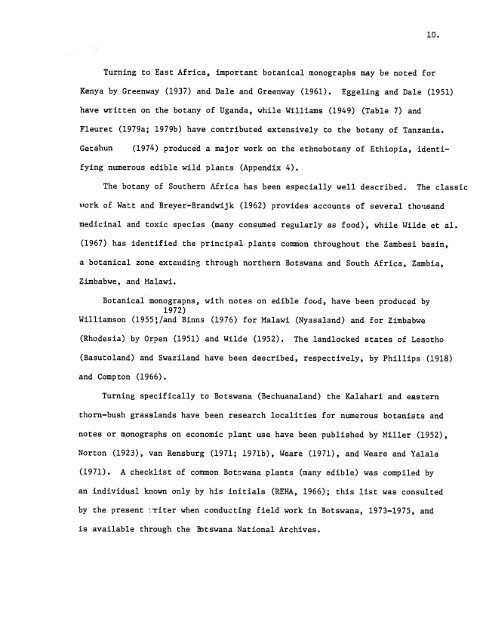BIBLIOGRAPHIC DATA SHEET
BIBLIOGRAPHIC DATA SHEET
BIBLIOGRAPHIC DATA SHEET
You also want an ePaper? Increase the reach of your titles
YUMPU automatically turns print PDFs into web optimized ePapers that Google loves.
Turning to East Africa, important botanical monographs may be noted for<br />
Kenya by Greenway (1937) and Dale and Greenway (1961). Eggeling and Dale (1951)<br />
have written on the botany of Uganda, while Williams (1949) (Table 7) and<br />
Fleuret (1979a; 1979b) have contributed extensively to the botany of Tanzania.<br />
Getahun (1974) produced a major work on the ethnobotany of Ethiopia, identi<br />
fying numerous edible wild plants (Appendix 4).<br />
The botany of Southern Africa has been especially well described. The classic<br />
work of Watt and Breyer-Brandwijk (1962) provides accounts of several thousand<br />
medicinal and toxic species (many consumed regularly as food), while Wilde et al.<br />
(1967) has identified the principal plants common throughout the Zambesi basin,<br />
a botanical zone extending through northern Botswana and South Africa, Zambia,<br />
Zimbabwe, and Malawi.<br />
Botanical monographs, with notes on edible food, have been produced by<br />
1972)<br />
Williamson (19551/and Binns (1976) for Malawi (Nyasaland) and for Zimbabwe<br />
(Rhodesia) by Orpen (1951) and Wilde (1952). The landlocked states of Lesotho<br />
(Basutoland) and Swaziland have been described, respectively, by Phillips (1918)<br />
and Compton (1966).<br />
Turning specifically to Botswana (Bechuanaland) the Kalahari and eastern<br />
thorn-bush grasslands have been research localities for numerous botanists and<br />
notes or monographs on economic plant use have been published by Miller (1952),<br />
Norton (1923), van Rensburg (1971; 1971b), Weare (1971), and Weare and Yalala<br />
(1971). A checklist of common Botswana plants (many edible) was compiled by<br />
an individual known only by his initials (REHA, 1966); this list was consulted<br />
by the present Triter when conducting field work in Botswana, 1973-1975, and<br />
is available through the Btswana National Archives.<br />
10.

















